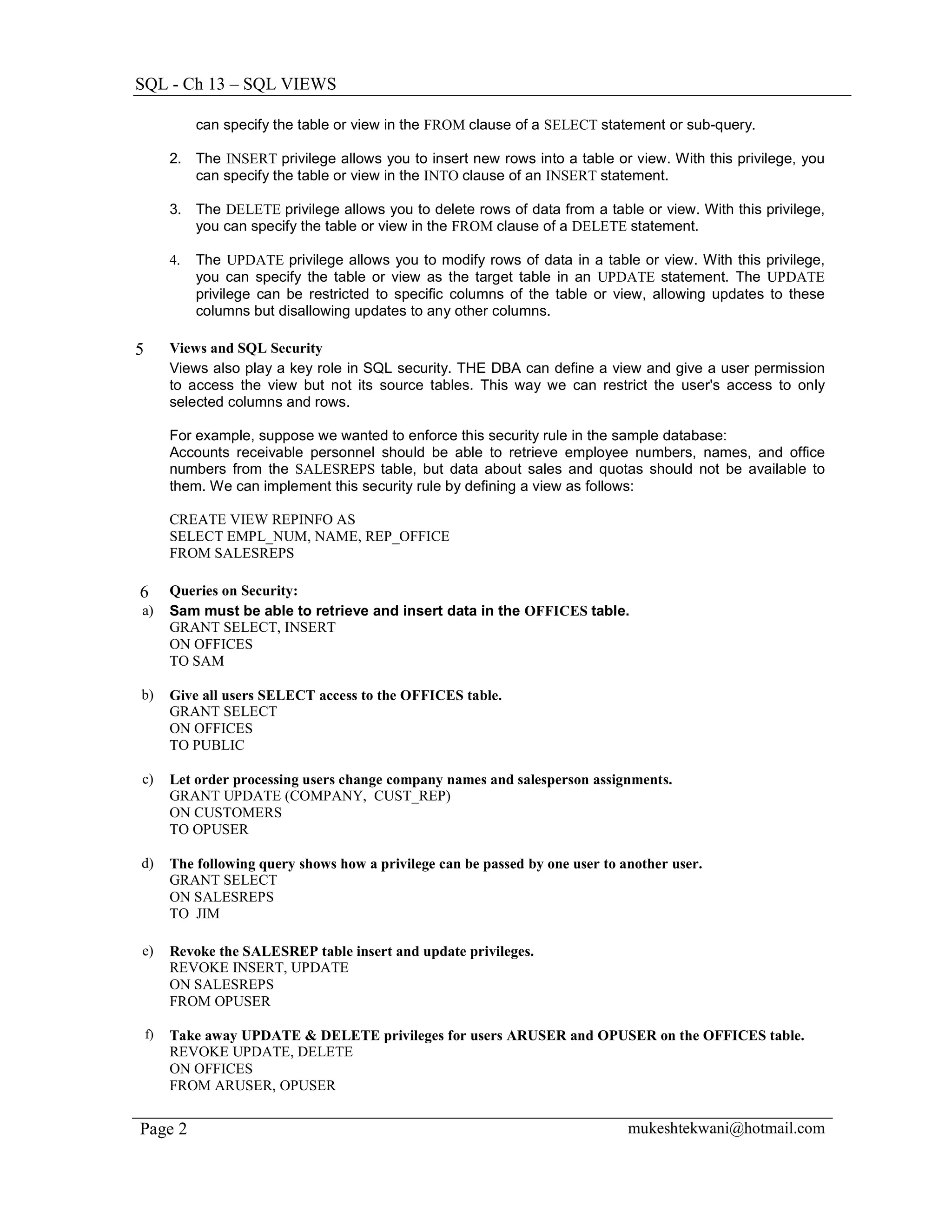This document discusses SQL security concepts including users, database objects, privileges, and how the security scheme is established. It defines users as those making requests to the database, database objects as items security can be applied to like tables and views, and privileges as actions users can perform on objects like select, insert, update, delete. The security scheme is established using GRANT and REVOKE statements to specify which users have which privileges on which database objects. Views can also be used to restrict user access to only selected data. Examples show granting and revoking privileges on different database objects for various users.
![SQL – Ch 15 – SQL SECURITY
15. SQL SECURITY
1 What are the security requirements of a database?
In any multiuser environment, data security is very important Some of the security requirements of an
organization are:
1. The data in any given table should be accessible to certain users only.
2. Only authorized users should be allowed to update data in a particular table; others should only
be allowed to retrieve data.
3. For some tables, access should be restricted on a column-by-column basis.
4. Some users should be denied interactive SQL access to a table but should be allowed to use
applications programs that update the table.
2 With reference to SQL security, define the following concepts: users, database objects, and privileges.
Users are a main component in the database. Every time the DBMS retrieves, inserts, deletes, or
updates data, it does so on behalf of some user. The DBMS permits or prohibits the action
depending on which user is making the request.
Database objects are the items to which SQL security protection can be applied. Security is applied
to tables, views, forms, application programs, and entire databases. Most users will have permission
to use certain database objects but will be prohibited from using others.
Privileges are the actions that a user is permitted to carry out for a given database object. A user
may have permission to SELECT and INSERT rows in a certain table, for example, but may be denied
permission to DELETE or UPDATE rows of the table. A different user may have a different set of
privileges.
3 How is the security scheme established for a database?
The SQL GRANT statement is used to specify which users have which privileges on which database
objects. For example, the following GRANT statement lets Sam retrieve and insert data in the
OFFICES table.
Let Sam retrieve and insert data in the OFFICES table.
GRANT SELECT, INSERT
ON OFFICES
TO SAM
Here SAM is the user-id, the object is the OFFICES table, and the privileges are SELECT and INSERT.
Take away the privileges granted earlier to Sam Clark.
REVOKE SELECT, INSERT
ON OFFICES
FROM SAM
Grant all privileges to SAM
GRANT ALL PRIVILEGES
ON SALESREPS
TO SAM
4 What are the various security objects?
SQL security protections apply to specific objects contained in a database. These are tables, views,
domains, stored procedure.
Privileges:
The set of actions that a user can carry out against a database object are called the privileges for the
object. The four basic privileges for tables and views are:
1. The SELECT privilege allows you to retrieve data from a table or view. With this privilege, you
Prof. Mukesh N. Tekwani [9869 488 356] Page 1](https://image.slidesharecdn.com/sql-ch15-sqlsecurity-110611035255-phpapp01/75/Sql-ch-15-sql-security-1-2048.jpg)

![SQL – Ch 15 – SQL SECURITY
g) Take away all privileges on the OFFICES from to all users.
REVOKE ALL PRIVILEGES
ON OFFICES
FROM PUBLIC
h) User SAM wants to grant update and select privileges on the software table to another user GROFF and
he wants to let him grant these permissions to other users.
GRANT SELECT, UPDATE
ON SOFTWARE
TO GROFF
WITH GRANT OPTION
Prof. Mukesh N. Tekwani [9869 488 356] Page 3](https://image.slidesharecdn.com/sql-ch15-sqlsecurity-110611035255-phpapp01/75/Sql-ch-15-sql-security-3-2048.jpg)